
See.Sense
ID: 3566
October 28, 2021
Reactive bike lights utilise sensor technology to protect cyclists and help cities improve infrastructure.
ID: 4369
June 2, 2022
DunavNET helps and supports corporate digital journeys with solutions and consulting services that are built on a strong foundation of technology and research. The company designs, develops and implements turnkey solutions that leverage IoT, machine learning and artificial intelligence technologies. An extensive portfolio of solutions is offered to support digital transformation in various domains, with farming and food operations being the main areas of focus. The company was established in 2006 in Novi Sad, Serbia, and has since then grown to establish an additional office in Dublin, Ireland, and employ more than 30 people, whose core expertise lies in computer science (IoT/ML/AI) and software engineering.
DunavNET provides complete digitalisation solutions to their clients so they can focus on their core business. Agriculture related solutions are built on standardised, enterprise-grade technologies and components, using Microsoft Azure as usual the foundation to ensure scalability, cost-effectiveness, reliability, and security. The primary focus of DunavNET is to enable digital transformation of the food value chain, from farm to consumer, achieving more efficient, sustainable, and transparent food production. The company strives to become a top provider of IoT corporate solutions for the smart agri-food domain with a strong contribution to the sustainable development of the world.

poultryNET is a platform that DunavNET offers to support farmers in increasing efficiency and control in poultry farms. The solution collects data in the poultry barn and throughout the supply chain and provides decision support instructions based on real-time observations. It enables farmers to manage all steps in the broiler production, enabling better farm management with high quality of meat while reducing negative environmental impact and respecting animal welfare. The poultryNET solution is applicable for broiler farms, parental flocks and laying hens.

The incentive for DunavNET to develop their IoT solution derives from the global concern that traditional agriculture will not to be able to meet the raising demands food caused by our growing World population. Inefficient practices in the domain negatively impact the productivity, the climate and, in some instances, the health and welfare of animals. DunavNET strives to implement new technologies, making the domain more intelligent, sustainable, and streamlined for the future.
Growing food demand has increased the need for animal protein. This need currently exceeds the demand by 1.7% per year, resulting in global annual poultry production reaching over 103.5 million tons [1]. To meet the growing demands, poultry farmers are put under pressure to make their farms more efficient to produce enough high-quality meat while also respecting animal welfare. Optimal management of poultry farms includes providing proper and safe farm conditions, providing accurate amount and type of feed, preserving proper hygiene and maintaining good health care. However, it is a challenge for poultry farmers to coordinate all the activities and gain a holistic view of farm and production, as chicken farms generally do not have integrated farm management systems. The data available for farmers to decide and act upon often rely on isolated raw measurements that are available on-site only, thus limiting their usability. This lack of timely information may increase the cases of diseases appearing in the poultry, leading to high usage of antibiotics and/or high rates of mortality. There are no applicable one-size-fits-all practices in poultry farming where also environmental parameters influence heat stress and general welfare, which can decrease feed intake and growth rate, disturb carbohydrates metabolism and protein synthesis, impair immunological response and change intestinal microflora – all having an undesirable impact on the body composition and meat quality of the chickens. Essentially, non-optimal farming procedures significantly affect the quantity and quality of the poultry production and may be sources of huge losses for the farmer.
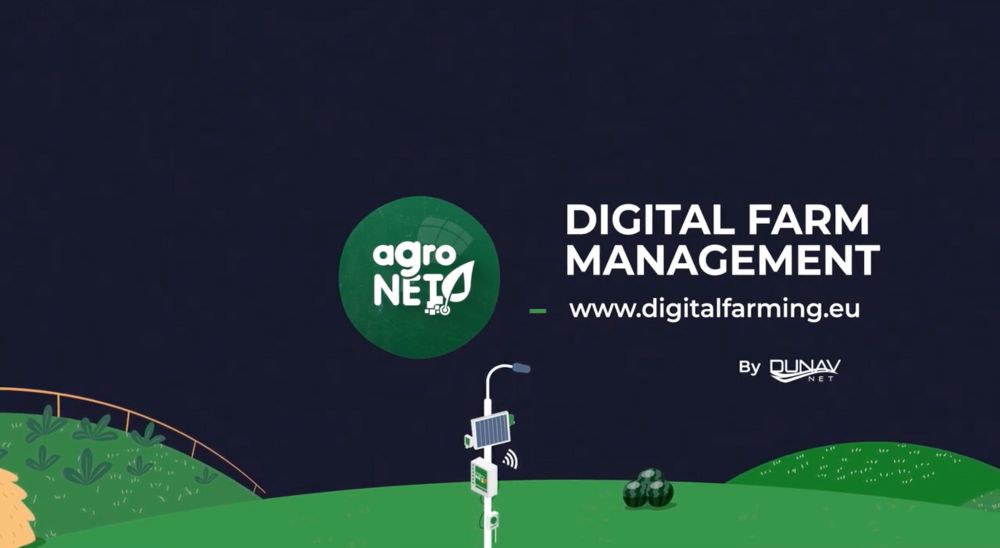
poultryNET is a solution that is built as a part of DunavNET’s all-agro-purpose platform agroNET, which was conceptualised in 2015. Involvement in a range of European projects allowed DunavNET to set up pilots that deployed the solution in various types of poultry farms and geographical locations. These projects offered occasions for the company to engage farmers and other stakeholders in open discussion and collect feedback while testing the features and functionalities of the solution. This approach helped DunavNET to enhance and extend the hardware and software of poultryNET in several iterations.
“We are listening to farmers that are deploying the solutions, learning from the feedback and then improving and extending this solution.”
Senka Gajinov, Product Manager at DunavNET
Over the next half-decade, further iterations were made to build an integrated data view of all farm operations, making agroNET a central hub for overcoming fragmentation of data generated by equipment from different vendors in agricultural digitalisation. The solution of today is an end-to-end platform that combines physical devices for data collection with edge and cloud-based components where the information is gathered, and the artificial intelligence algorithms executed. IoT devices are deployed in the barn to gather information about the behaviour and vocalisation of the chickens, as well as other potentially relevant parameters related to the barn facilities, the indoor environment and production machinery. The platform provides a range of data analytics modules designed to provide real-time guidance and support to farmers in the optimal management of their poultry production.
The development of poultryNET is an ongoing process, and DunavNET continuously adds new features as they carry on with learning more about the needs and requirements of farmers and other stakeholders. A more recent demand was posed by the consumers at the very end of the food supply chain, who are becoming more conscious about the sustainable and ethical footprints of food production as well as the quality of the food, the level of antibiotic residues and the welfare of the slaughtered animal. Hence, consumers are increasingly setting up requirements for the origin of what they ingest and demand transparency from farm to fork. DunavNET is responding to this by extending the poultryNET solution to include a supply chain perspective in collaboration with partners like OriginTrail, providing easily accessible traceability data that enlighten consumers and ecosystem partners about the production and handling of specific animals on a specific farm. Different solutions that address agriculture production are available on the market, however, these solutions are usually isolated, focused on one farm operation, without possibility of analysing different data sets thus lacking the holistic overview and decision support based on rich set of data analysis that poultryNET can provide.
“Well, you always have competitors, and that is a good thing. It is something that makes you become better every day.”
Senka Gajinov, Product Manager at DunavNET
The poultryNET solution combines hardware engineering and software development and offers a cloud-based platform for monitoring and managing operations related to poultry production. The physical components of the solution cover a range of poultryNET devices that are installed in the poultry barn. These devices include 1) a camera and microphone that harvest optical and audial data in the form of video and sound, and 2) indoor environment sensors that measure air temperature, humidity, CO2 and NH3 levels. In addition to these devices are also a range of 3) optional add-on devices that collect data whose relevance depend on the specific barn in which they are deployed. Examples of these devices are sensors for measuring airflow, light intensity and water and feed consumed.
The collected data is transmitted to the agroNET server via either cellular GPRS [2], Wi-Fi [3] or LoRaWAN [4] network. The agroNET server is hosted by a Microsoft Azure cloud platform to ensure reliable and secure communication between IoT devices, application interfaces and potential third-party integrations.
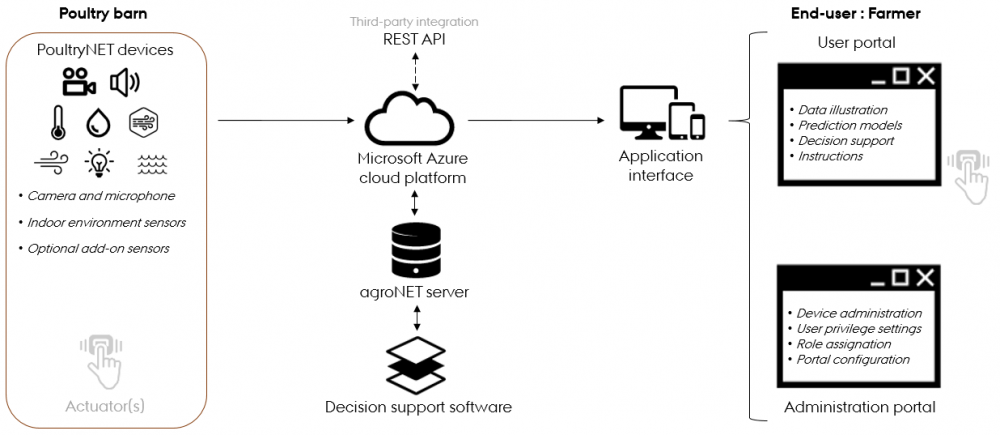
Data processing can take place locally on the devices and on the cloud platform. The agroNET server feeds the data into an analysis and decision support software, which outputs information to application interfaces that are available via mobile or web to the end-user:
These applications facilitate remote monitoring of the barn and production including remote management of the poultryNET devices. The user portal visualises the collected data on intuitive dashboards, often illustrated through graphs, charts and tables, offering a complete overview with real-time monitoring of the poultry while also providing statistical insights and basic analytics across all monitored parameters.
The agroNET server uses decision support software to process the data which enables digitised models to generate insights on welfare and diseases throughout the life cycle and growing progression of the chickens. This essentially increases control over the poultry production and enables more sustainable farming, as the living conditions of the chickens are optimised, meaning an increase in welfare and survival rate, and, ultimately, an increase in produced meat quality and quantity.
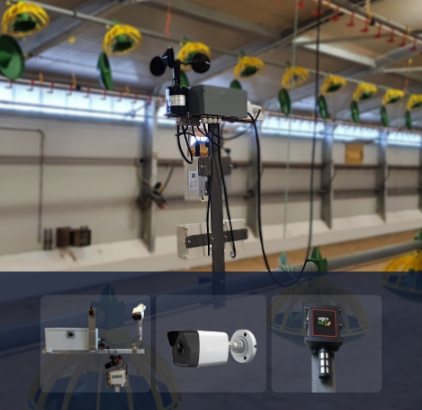
The platform can process information about the behaviour and vocalisation of the chickens, and, based on data processing in the cloud, generate recommendations, for example on when, to feed the chickens, and how to ensure optimal growing conditions. Finally, the IoT observations pave the way for providing real-time alerts and instructions to the farmers, including advice on specific activities to be undertaken in order to optimise growing and health conditions.
“We are using IoT technologies for creating all of our solutions.”
Senka Gajinov, Product Manager at DunavNET
All data is made available via REST APIs to enable interoperability with other devices, services as well as third-party systems. This enables the data to be incorporated into a so-called ‘product passport’ and shared between partners up- and down-stream throughout the supply chain linked to the specific farm. A ‘product passport’ provides unique identification of each product unit and/or batch and digital monitoring of its movements and transformations from the source to the place of consumption in a decentralised, reliable and immutable way. The data exchange protocol used for the purpose is blockchain-based to ensure trust and transparency between actors and the integrity of the data exchanged.
The development of DunavNET’s IoT solution is a contribution to the global ambitions for more intelligent, sustainable and transparent agricultural practices. Such solutions are prevalent in streamlining the domain to the future, fostering impactful climate initiatives and enlightening consumers. The AI platform facilitates a sustainable transformation in the practices of poultry farm management that makes poultry production more efficient and capable of meeting the growing demand for high-quality meat while also respecting animal welfare and the planet.
“We are actually enabling farmers to capture and collect all relevant farm data in one place and then do analytics across the rich set of data instead of running multiple isolated applications.”
Senka Gajinov, Product Manager at DunavNET
Ultimately, this data-driven insight and overview can support farmers in attaining maximum production output with more organised and precise practices. The noticeable outcomes that can be derived from the poultryNET solution largely rely on the following distinctive features:
To DunavNET, the poultryNET platform is one of many services in an extensive service ecosystem that together generate the revenue streams of the company. Monetary outcomes are harvested through a continuous profit mechanism based on software subscriptions, and on top of that is DunavNET keen to explore the monetisation of data.
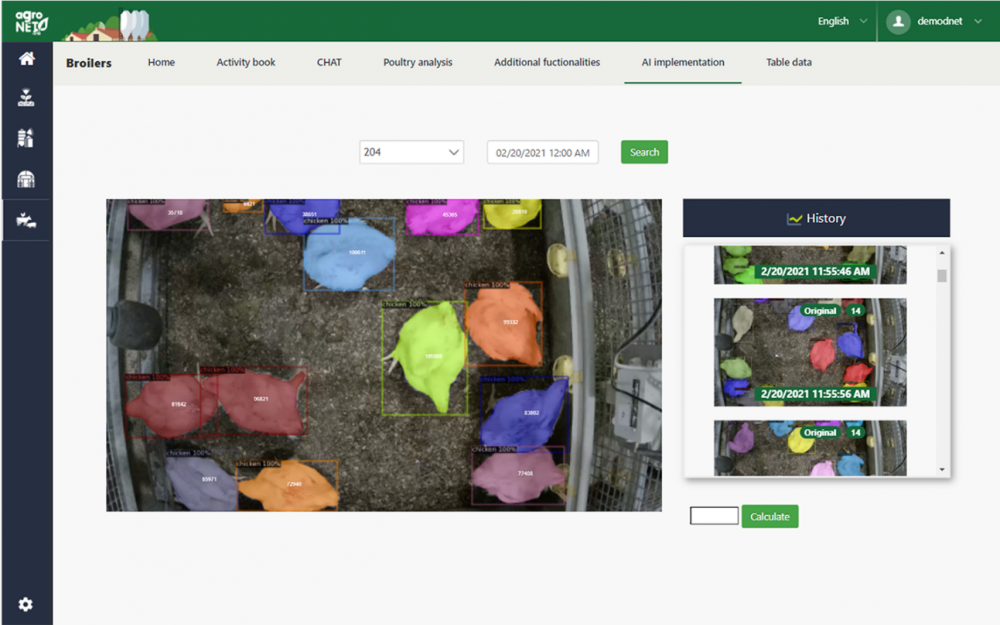
Direct customers of the solution include independent farmers and agricultural corporations engaged in poultry production. Indirect customers include 1) consultants that advise end-users on agricultural digitalisation, as the incorporation of poultryNET as part of their service enables them to decrease the time they spend visiting the farm, and 2) suppliers of poultry machinery and devices (e.g. feeder and nipple systems, brooders, heaters etc.), as poultryNET can serve as an added value offering to their own product portfolio.
These various customer groups, as well as the hands-on end-user – the farmer, deploy the poultryNET solution for on-farm activities, and the value proposition is therefore in essence constituted by the above-listed features. However, alongside the on-farm actors are also a range of post-farm actors that are able to leverage valuable outcomes from, not the features, but the data generated by the solution. Serving as input for the product passport, this data enables supply chain partners and end-consumers digital traceability of the meat throughout the food production process and transparency of the journey from farm to fork. Hence, based on the usage of the poultryNET solution, beneficial outcomes can be summarised into:
On-farm actors:
“Embedded expert modules and data analytics are the core value of the agroNET.”
Senka Gajinov, Product Manager at DunavNET
Supply chain partner and end-consumers:
“The more data we collect from the fields, the more value it will be possible to create, so focus will move from on-the-farm activities to the complete value chain.”
Senka Gajinov, Product Manager at DunavNET

Illustration 5: The poultryNET dashboard visualises real-time observations and a dedicated web applications allow farmers to easily manage all farm activities and steps of the poultry production remotely.
Since DunavNET introduced the idea of an IoT/AI platform to increase efficiency while supporting animal welfare and sustainability in livestock production, many technological iterations have passed, and many valuable learnings have emerged. Some of them with potentially transmissible value for other actors in the IoT ecosystem.
“The agriculture market is very specific and the adoption of new technology is a slow process.”
Senka Gajinov, Product Manager at DunavNET
The essential learning for DunavNET has indeed been the importance of establishing a strong ecosystem of partners to nurture scalability, development and growth of the business. This ecosystem has enabled the company to quickly and effectively being able to deploy poultryNET at numerous poultry farms, and it has created the basis for expanding the client base as well as the functionalities and features of the solution. DunavNET relies on partners ranging from hardware vendors to communication network providers and system integrators to build the custom solutions, as well as the international IoT community, researchers and innovators in the field to share knowledge. With these partners, DunavNET can rapidly and efficiently deliver the most complex IoT solution anywhere in the world.
DunavNET considers a number of points to be vital for the success of their IoT solution so far. Taking departure in the journey of development and implementation of poultryNET, these points are compiled into a list of recommendations below:
1. User feedback
“We are talking with farmers and that is always our starting point. It is very important to understand their needs and their problems.”
Senka Gajinov, Product Manager at DunavNET
User feedback is the guide for development and addition of new features, functionalities and services to IoT solutions. DunavNET emphasises the significance of listening to users as they deploy the company’s solutions, learning from the feedback they provide and, based on this, enhancing and extending the solution. As standard practice, DunavNET works directly with the farmers during design and validation of the solution, and beyond the initial phase, the company keeps a direct link to a number of strategic stakeholders throughout the supply chain.
2. Penetrate the market with trust and support
Gaining the trust of the end-users is essential to facilitate penetration of a market domain as traditional as agriculture with solutions that are built on novel technology. In the early commercialisation of poultryNET, DunavNET was challenged by this matter and had many difficulties convincing farmers about the value to derive from the solution. For IoT innovators that operate in similar markets, DunavNET recommends seeking the initial customer acquisition through peers of the targeted user: Focus on identifying the trendsetters, engage relevant stakeholders from the network and offer open support. From experience, DunavNET finds that once the first well-renowned customer is signed up and usable as a reference use case to illustrate the value of the solution, tables are turned. Hence, the influence of word of mouth cannot be underestimated, and support beyond the point of sale is crucial in sustaining the trust.
“Supporting the end-users is very important for successful implementation and commercialisation of solution.”
Senka Gajinov, Product Manager at DunavNET
3. Educate users on the value proposition
Being able to clearly communicate the benefits for users to gain from a solution is crucial. DunavNET does this proactively by promoting the value of new technologies in agricultural teaching and by providing first-line support to customers.
“It is very important to explain to farmers what technology can do for them so that they can better define their needs according to that.”
Senka Gajinov, Product Manager at DunavNET
When offering advanced IoT solutions, it may furthermore be necessary to educate the users on how to actually use the technology, making sure that they understand its features and are able to make the best of it. This point is crucial in the case of poultryNET because the value proposition emerges as a consequence. During this education process, DunavNET recommends experts to keep it simple and gradually build on top of the farmers’ newly acquired technological capabilities.
One final insight shared by DunavNET when reflecting upon the means for achieving success with IoT solutions is a specification of the most crucial determinants being confidence, curiosity, persistence and passion.
“We believe in ourselves, and then we believe in data! … believe in data and understand the end-users for whom you are preparing a solution.”
Senka Gajinov, Product Manager at DunavNET
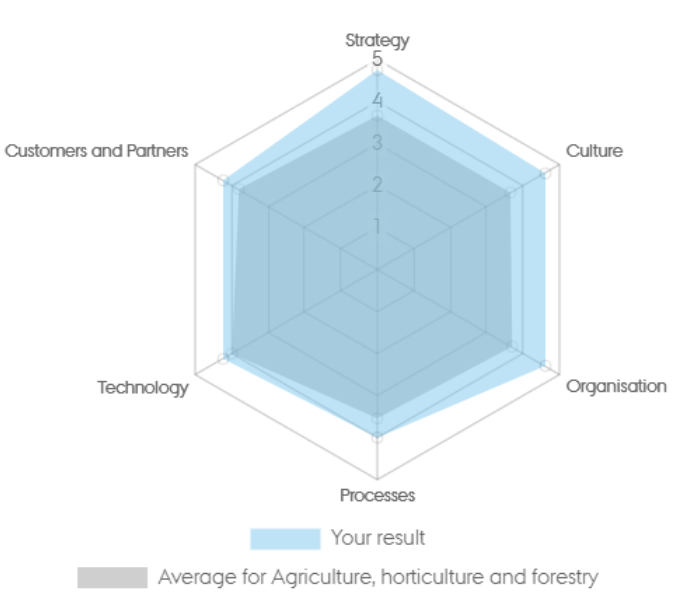
DunavNET assumes a high level of digital maturity with an overall score of 4.41. The score indicates that the digital capabilities of the company are vastly mature, and that they perform above average for the Agriculture, horticulture and forestry sector.
The Digital Maturity Assessment Tool is copyrighted by Associate Professor and PhD Annabeth Aagaard, Director at the Interdisciplinary Centre for Digital Business Development, Aarhus University. To get the digital maturity of your company mapped out, click here.
[1] USDA. Foreign Agricultural Service. Livestock and Poultry: World Markets and Trade.
[2] GPRS (General Packet Radio Service): a packet-switching technology that enables data transfers through cellular networks.
[3] Wi-Fi: a wireless networking technology that uses radio waves to provide wireless high-speed Internet access.
[4] LoRaWAN: a Low Power, Wide Area (LPWA) networking protocol designed to wirelessly connect battery operated ‘things’ to the internet.

Copyright notice: © 2020 – 2023 EU-IoT Consortium.
This material was produced as part of the EU-IoT project, grant ID 956671, and is funded by the Horizon 2020 Framework Programme under topic ID ICT-56-2020.
EU-IoT is the European IoT Hub. The EU-IoT project works towards growing a sustainable and comprehensive ecosystem for Next Generation Internet of Things.
Source of origin: Information to document this use case originates from the H2020 call: DT-ICT-13-2019 Digital Platforms/Pilots Horizontal Activities (CSA); Project Open DEI 857065; Period: 01-05-2019 to 31-12-2022; EC contribution 2 mil. EUR.
